Orchid - an elegant plant with beautiful flowers, belongs to the family of monocotyledonous flowers. It grows rapidly, so periodic transplantation is required. If this is not done on time, then it will begin to gradually fade and die.
Content
How to determine if a flower needs a transplant
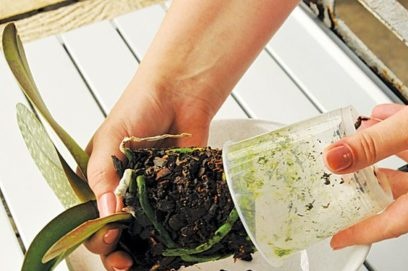 To properly transplant an orchid, you need to be able to determine when this process is needed. Several modifications of the plant can suggest this:
To properly transplant an orchid, you need to be able to determine when this process is needed. Several modifications of the plant can suggest this:
- vegetation began to appear on the inner and outer walls of the pot: moss or algae;
- the roots of the flower began to rot;
- the root system has grown and already occupies the entire space of the pot;
- pests appeared in the soil;
- leaflets of the flower began to turn yellow and fade; even heavy watering does not contribute to their restoration.
All these signs indicate that the plant culture began to exist in an unfavorable environment. If in the near future the orchid is not transplanted into another pot, then it will begin to fade more and more, it will soon die.
Transplant Features
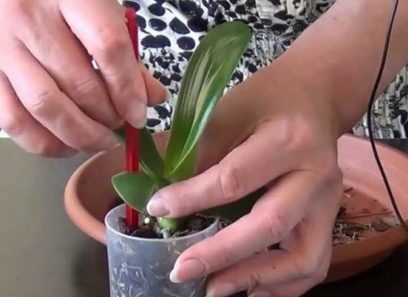 An orchid is called an everlasting plant. This is due to the fact that flowers are always present on it. Due to the fact that she is not at rest, it becomes difficult to choose a time when you can transplant an orchid. The best time for this is from February to mid-March. If possible, it is recommended to turn off the central heating during this procedure, as the plant will rest a bit from the hot air, then begin to grow actively.
An orchid is called an everlasting plant. This is due to the fact that flowers are always present on it. Due to the fact that she is not at rest, it becomes difficult to choose a time when you can transplant an orchid. The best time for this is from February to mid-March. If possible, it is recommended to turn off the central heating during this procedure, as the plant will rest a bit from the hot air, then begin to grow actively.
Phalaenopsis orchid transplant after purchase
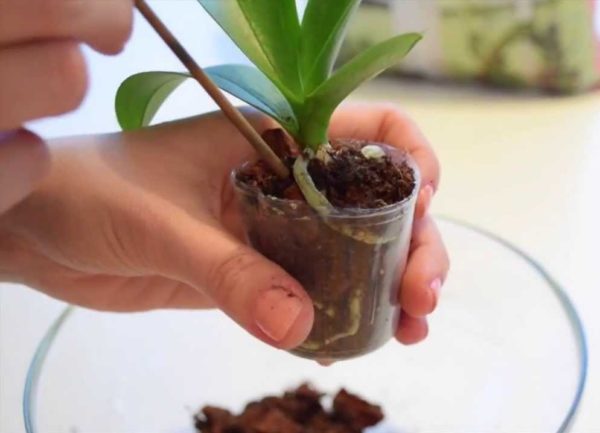 Orchid is sold in a store in a small pot. Immediately after the acquisition, the purchased plant should be transplanted so that it has enough space for further growth. If it is still small and not strong, then there is no need to rush with this process. Transplanting an orchid after purchase is required only in the following cases:
Orchid is sold in a store in a small pot. Immediately after the acquisition, the purchased plant should be transplanted so that it has enough space for further growth. If it is still small and not strong, then there is no need to rush with this process. Transplanting an orchid after purchase is required only in the following cases:
- if cracks or chips are found on the pot;
- if they are made of dense material that is not able to transmit light;
- when signs of drying out or the formation of rot and mold appear under the roots;
- if the plant has been planted in improper soil, which accumulates excess moisture.
If the flower is actively blooming, it has bright green petals and a healthy root system, then it is not necessary to transplant Phalaenopsis. Florists recommend waiting for the period when the plant gets stronger, acclimatizes in the house and completely fades.
Is it possible to transplant a blooming orchid
During flowering, flowers cannot be transplanted. This is due to the fact that moving them to a new place may result in withering or death. But, sometimes it becomes necessary to do this before the flowering is complete, if the plant culture is in danger, for example, if the roots are in poor condition or if pests eat them.
In this case, you can transplant an orchid, but you need to do this strictly without destroying the root coma and removing roots.The only thing that can be done is to cut the peduncle on a sleeping bud so that the plant blooms better during the next flowering. If you carry out the transfer in accordance with these rules, the plant will tolerate the planting well and quickly acclimatize to a new place.
In a glass vase
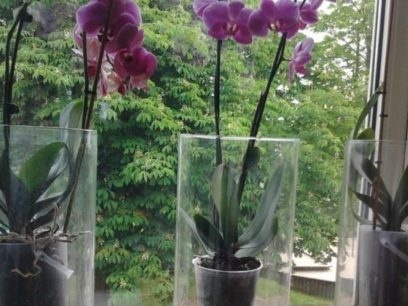 It is standardly recommended to transplant an orchid from one pot to another, they are different in volume or design. Less commonly, it becomes necessary to transplant the plant into a glass vase. There are several positive aspects of this manipulation:
It is standardly recommended to transplant an orchid from one pot to another, they are different in volume or design. Less commonly, it becomes necessary to transplant the plant into a glass vase. There are several positive aspects of this manipulation:
- the flower looks beautiful, complements the overall design of the living room or bedroom;
- it can be watered less often due to the high light transmittance of the dishes;
- it becomes easier to monitor the state of the soil and the measles system.
But, transplanting a flower from a pot into a vase is not so simple. Sometimes, even experienced flower growers cannot cope with this task. For a plant, such manipulation is very stressful, and it does not take root well in a new place. It is important that the glassware was made of dense material, had a width no less than the width of the pot in which it was previously.
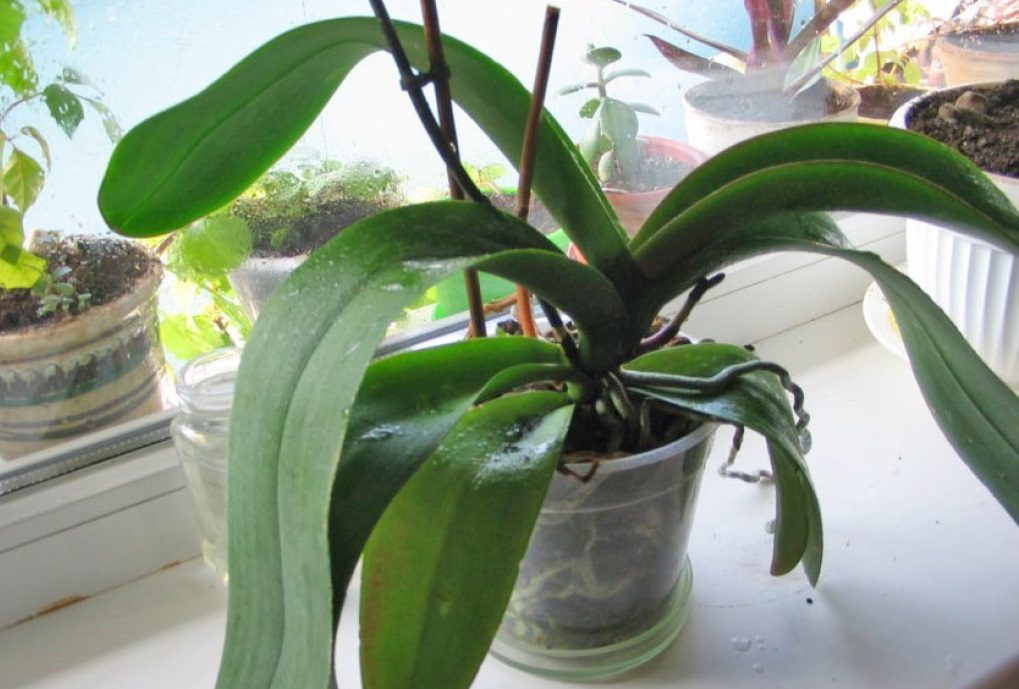 You may be interested in:
You may be interested in:Old orchids
The hardest thing is to transplant the old Phalaenopsis. The plant is already weakened, and the additional stress received during the transplant can lead to death. The movement occurs, as with a young plant, but the distinguishing feature is that during manipulation it is required to exercise maximum caution. Not a single root should be damaged. Usually, they have a long, lush root system, which is easy to damage.
Phalaenopsis kids
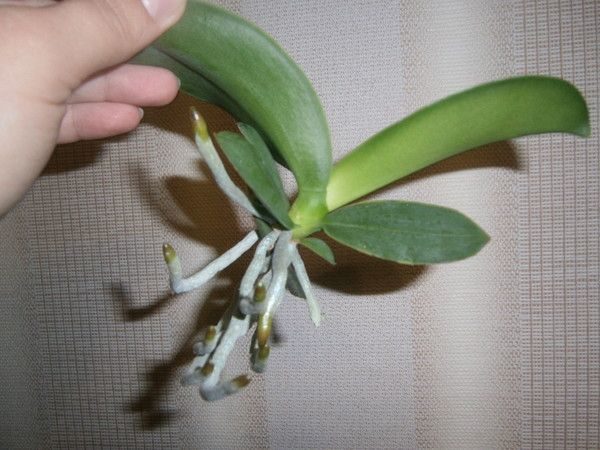 Often, after an orchid transplant, flower growers find that individual sprouts were present in the root system, in other words, they are called Phalaenopsis babies. They also need to be transplanted into a new container, but separately from an adult flower. In this case, several conditions must be observed for its full survival:
Often, after an orchid transplant, flower growers find that individual sprouts were present in the root system, in other words, they are called Phalaenopsis babies. They also need to be transplanted into a new container, but separately from an adult flower. In this case, several conditions must be observed for its full survival:
- the pot should be small in size;
- the sprout must be carefully washed with running water;
- additional drainage should be created in the tank, adding charcoal to it;
- it must be placed in the center of the pot.
Periodically after planting, it is required to pick up the pot and shake it well. This measure is necessary to fill free voids. Many beginners do not know whether to water a young orchid after a transplant. Florists assure that this measure is necessary so that the plant takes root well.
How often to transplant
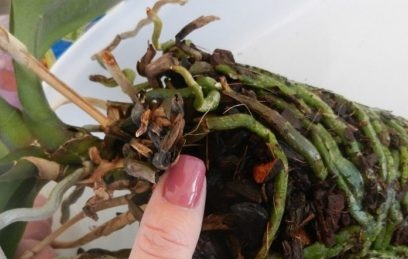 After the orchid transplantation has been completed, after purchase it does not need to be touched for 2-3 years. During this time, it will grow and it will need a new capacity. Before, it becomes necessary to do this only if something threatens the life of the plant.
After the orchid transplantation has been completed, after purchase it does not need to be touched for 2-3 years. During this time, it will grow and it will need a new capacity. Before, it becomes necessary to do this only if something threatens the life of the plant.
The fact that the time has come to transplant a grown orchid at home, will be indicated by such signs as covering the soil with moss and the death of the central part of the root system. You should pick a larger pot, carefully trim the dried dead parts of the plant and plant it in new soil to the level of the lower leaves.
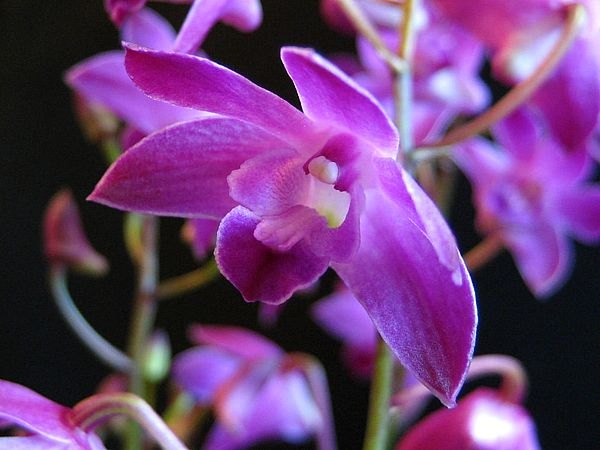 You may be interested in:
You may be interested in:Transplant Instructions
Transplanting orchids after flowering is a complex process. You can cope with it if you know the timing and frequency, the rule for choosing a substrate and a pot, and observe the methods and technology of the process. Then it will be possible to prevent the occurrence of stress in the plant, thereby protecting it.
Dates and frequency
A common question among brand new gardeners is whether to transplant an orchid after purchase. If the plant looks healthy, actively grows, then it is recommended to do this no earlier than after 2-3 years. It is better to do this at the end of February. Further frequency of flower movement is also 2-3 years.
Substrate
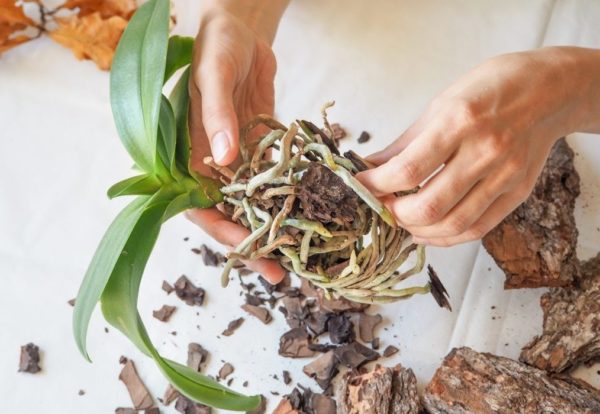 Substrate - a substance necessary for the full fixing of the plant in a new place, maintaining the optimal level of hydration of the root system. In stores for gardeners, there are several types of this component; for flowers, one based on pine and pine bark is suitable.
Substrate - a substance necessary for the full fixing of the plant in a new place, maintaining the optimal level of hydration of the root system. In stores for gardeners, there are several types of this component; for flowers, one based on pine and pine bark is suitable.
You can prepare pine bark to create a substrate yourself, but you should consider that it has a minimum amount of tar and surface contaminants. Before adding to the soil, you need to thoroughly rinse it, dry it, calcine in the oven, cut into cubes.
Pot
When choosing a new pot for transplanting phalaenopsis at home, you should study its condition. If the flower is healthy, then the dishes should be 1-2 sizes larger than the one in which it was previously. In it, the root system decomposes, the plant will comfortably germinate far. But, if most of the roots are rotten and they need to be pre-cut, then you can plant the flower in the same pot after processing or pick up a container of the same size.As for the material and color, it is better that this flower grows in a transparent bowl. Therefore, both a plastic container and a glass vase are equally suitable for this purpose. At the bottom of the tank there should be several small openings through which excess water will flow out, and air will enter, providing ventilation of the soil.
Methods and Technology
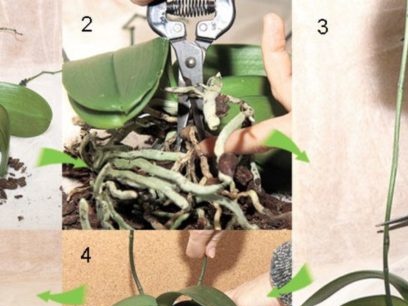 The Phalaenopsis orchid transplant should be carried out very carefully, given that this flower has a fragile root system, a sudden movement can damage it. When transplanting, you must follow the step by step instructions:
The Phalaenopsis orchid transplant should be carried out very carefully, given that this flower has a fragile root system, a sudden movement can damage it. When transplanting, you must follow the step by step instructions:
- Before transplanting into a pot, the plant should be watered. The roots are saturated with liquid, which will make them flexible and elastic, making them harder to damage. Rotten processes, on the contrary, will become easier to disconnect from the common root system.
- After watering the orchids during transplantation, you should slightly knead the contents of the pot with your fingers, trying to thoroughly stir up the old substrate. Only after this can you carefully remove the plant from the container.
- Roots need to be freed from excess land and old bark. After that, lightly moisten them under a stream of cool water.
- All rotten, damaged or dried up plant elements must be cut off. Places of cuts on the root system must be abundantly sprinkled with charcoal.
- The plant should be transferred to a newspaper or dense matter. The root should be completely dry. This may take 6 to 8 hours. Only then can it be transplanted.
- The flower should be placed in a pot with fresh soil. The roots need to be carefully straightened. If voids have formed, then you need to fill them with substrates.
Orchid is transplanted. If some aerial roots did not fit in the pot and remained on the surface, then there is nothing wrong with that. This does not affect the full growth of the plant. Next, you need to do watering after transplanting. It is better to carry out the process of supplying water through a shower or watering can.
Transplant Care
Even if you transplant the Phalaenopsis orchid at home step by step in accordance with all the rules recommended by experienced gardeners, it may die immediately after moving to a new place. This is due to the fact that after orchid transplantation, appropriate care for it was not carried out. The following conditions must be observed:
- the air temperature in the room should be at least 20 and no more than 25 degrees;
- it is not necessary to move the pot from place to place, it is required to ensure complete rest for it;
- within 10 days after transplantation, the phalaenopsis orchid should be completely in a darkened place;
- for 3-4 days, you do not need to water the orchid after transplanting, since by this time the bark will still retain moisture, only spraying is permissible, but at the same time observe that there is no accumulation of water on the leaves.
It is difficult to transplant a mini orchid so that it is firmly fixed in the soil. In the early days, it can be directed to the side. In this case, you need to tie its trunk to the edge of the pot wall with a soft rope or garter, you can remove it no sooner than after 2-3 months.
In the absence of flowering
There is no need to transplant the plant again if the plant shows no signs of the plant within a few weeks. This is a normal reaction that arose because the plant was under stress. Patience should be gained, in a few weeks it will recover and “revive” again. How quickly this happens depends only on how correctly and accurately it was possible to transplant and care for the plant.
What to do if the orchid withers after a transplant
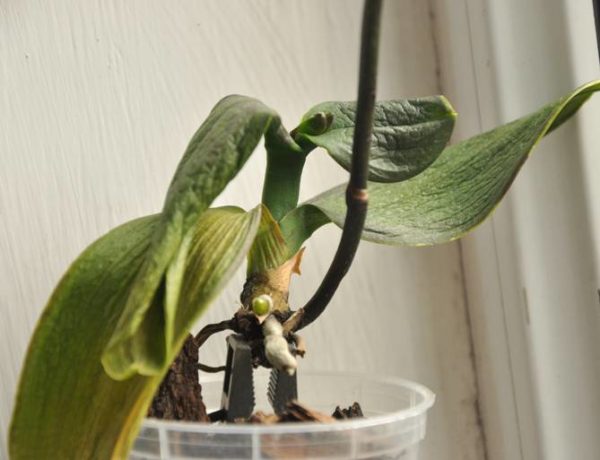 Another possible problem is that the flower began to fade after "relocation." Such a negative moment can be associated with 2 reasons:
Another possible problem is that the flower began to fade after "relocation." Such a negative moment can be associated with 2 reasons:
- orchid transplantation at home was carried out with a long delay, most of the root system by this time had already managed to rot;
- the plant stood in the sun for a long time, because of which more moisture began to evaporate from the leaves than through the roots;
- during the transplant after a purchase at the store or as needed, the root system was badly damaged.
The most important solution to the problem in such a situation is to rearrange the plant in the shade so that direct sunlight does not fall on it. In addition, it is required to spray it and cover the pot with a plastic bag so that the moisture does not evaporate.
Watering
After transplanting, you need to water the orchid no earlier than in 1-1.5 weeks. If its petals began to fade, then they can be easily sprayed, but not allowing moisture to enter the root system.
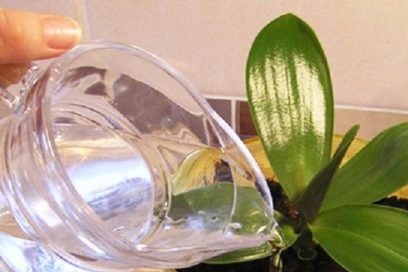
Possible mistakes
You can transplant the flower correctly in accordance with the step-by-step instructions, but it will not take root in a new place and will wither more and more every day. This is due to the fact that during the land work the gardener made one of a number of mistakes:
- Incorrectly selected soil. The soil should contain the necessary organic and mineral substances, providing the flower with good growth.
- Damage to the root system. Many gardeners do not know whether it is possible to prune orchid roots. Only damaged or dried out shoots need to be trimmed.
- Wrong pot selected. It must be created from transparent material, since the roots also participate in the process of photosynthesis.
- Wrong pot size. When choosing a capacity, you should focus on the power of the root system.
Orchid is a moody plant that requires careful care. Every 3 years it needs to be transplanted, otherwise, there will be little space in the pot, the roots will begin to die out, and the pot itself will wither. But, you need to do this in accordance with the step-by-step instructions and all the rules so as not to damage the plant culture.

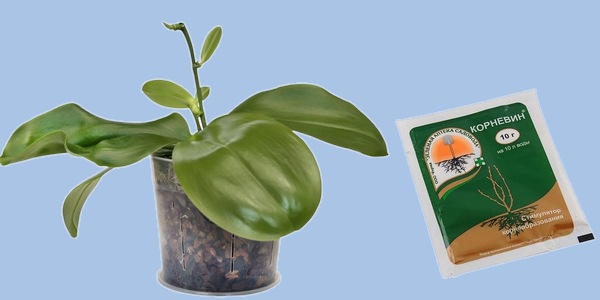
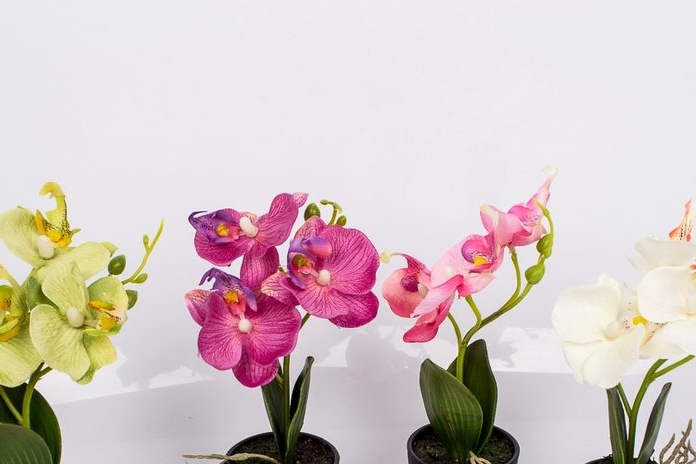
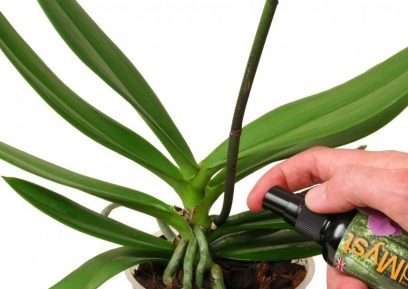
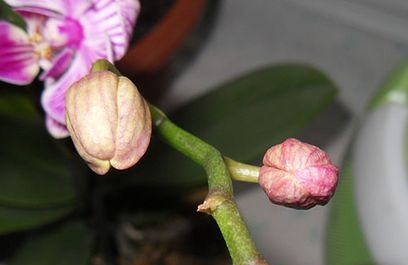 Reasons why orchids fall flowers and what to do
Reasons why orchids fall flowers and what to do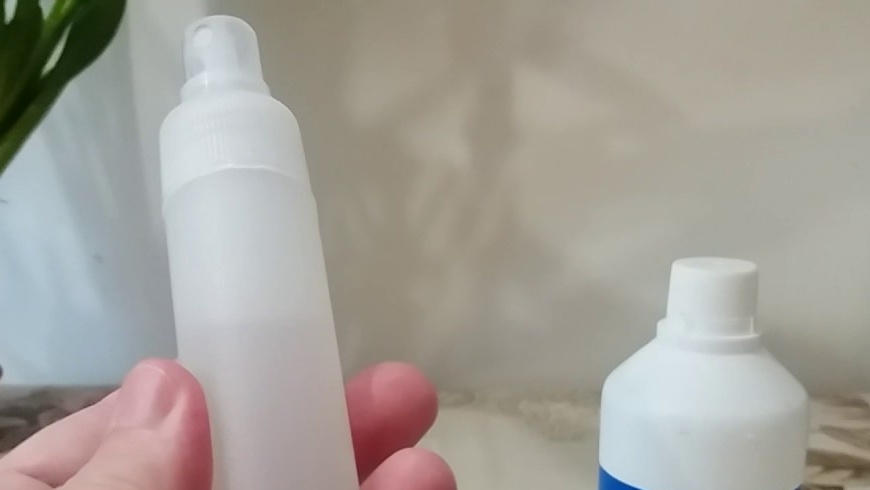 How to use hydrogen peroxide for orchids and why
How to use hydrogen peroxide for orchids and why Midges are wound up in the orchid: effective ways to get rid
Midges are wound up in the orchid: effective ways to get rid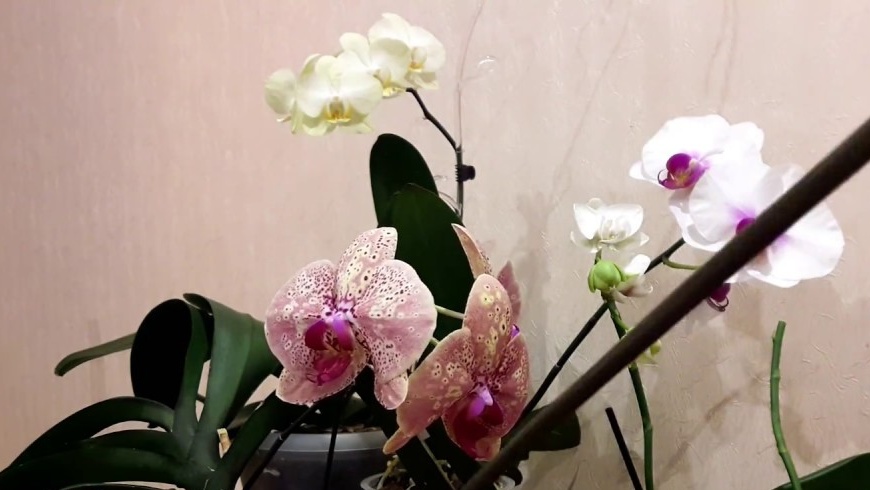 Is it possible to transplant an orchid during flowering
Is it possible to transplant an orchid during flowering